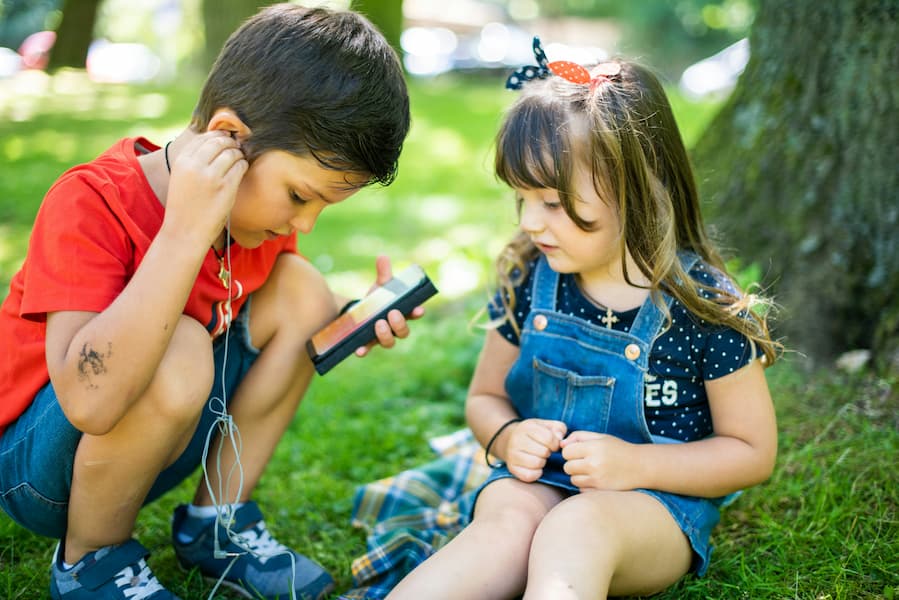Mobile phones are everywhere today and are part of modern society. Almost everyone has one, even toddlers. Many parents consider mobile phones as tools of temporary babysitting, soothing, or even simple learning aids. But actually, what would a mobile phone mean to a toddler? What are the repercussions of a child’s early exposure to mobile devices on their development? This paper delves into the relationship between toddlers and mobile phones, expanding on the risks, benefits, and expert-approved measures on how to cultivate healthy tech habits in children and understand the child’s behavior.
Why Do Toddlers Love Mobile Phones?
The Psychology Behind the Screen
What draws a toddler to mobile phones is their curiosity. The glowing screens, sounds and colors, and movement—everything simply arrests a child’s attention. All the US Parents should know that immediate feedback is guaranteed: a tap produces sound, and a swipe changes the image. All this interaction gives the toddler a sense of control and stimulation.
Bright Sounds and Interactivity
Mobile applications are highly interactive by design. Bright, animated visuals; sounds that are fun; and characters that are engaging make it highly addictive for devices. This constant stimulation can be a bit much for toddlers, as their attention spans are just beginning to develop, but are still quite irresistible. Imitating Adults
Most of all, what attracts a toddler to a phone is imitation. The child’s parents spend most of their days on the phone for work, communication, entertainment, and many other reasons. Surely, a toddler naturally imitates and thinks that using a phone is one of daily life’s necessities.
The Dangers of Toddlers and Mobile Phone Exposure in Early Life: Delays in Development

While the evidence may still be largely anecdotal, there is a lot of research that suggests too much screen time among toddlers is linked to delayed speech, attention issues, and reduced social interaction. A lot of normal face-to-face interaction and hands-on play is what a toddler needs for the development of essential motor and communicative skills. Thus, when handsets are overused, they obliterate these important experiences that children require for development.
Disturbed Sleep
Melatonin serves as a sleep-regulating hormone and is suppressed by the blue light from phone screens. Kids using phones, or more so in the wrong way, might induce a lack of falling asleep and trigger a cycle of wakefulness, leading to restlessness and potential behavioral problems. This may end in a restless and cranky day. Their mood, memory, and general health may be affected by having an altered sleep pattern.
Behaviors
Overexposure of these toddlers to mobile telephony might make them show signs of irritability, aggression, or impatience when the phone is taken away. This can easily develop into a screen addiction in toddlers by affecting their emotional health. Toddlers might also find frustration tolerance and attention spans greatly reduced.
Less Physical Activity
Another disadvantage of excessive screen time is that it is mostly at the expense of physical activity. Toddlers who spend more time on screens likely play less physically, which puts muscle development, coordination, and general fitness at risk.
Benefits of Limited and Guided Use: Toddlers and Mobile Phones
Educational content and games—Cell phones have access to good educational content when used moderately and under supervision. From applications that teach toddlers colors, numbers, shapes, and even languages in a fun and interactive way. It is here that these tools may be of help if properly applied to offer complementary support to early learning.
The development of visual and auditory skills
Appropriate digital media can help develop better visual and auditory processing skills. For instance, songs, rhymes, and animated stories in younger children are known to enhance listening and understanding abilities. At the same time, such content also promotes memory retention and helps develop new vocabulary.
Strengthening the Parent-Child Bonding Through Co-Engagement
When parents and children use the mobile content together, the experience becomes interactive. Talking about the on-screen activities, asking questions, and prompting responses, there can be a vast scope for building communication and emotional bonding this way.
Expert-Recommended Guidelines for Screen Time:
WHO and AAP guidelines for toddlers
The parents or caretakers should adhere to the WHO guidelines and the American Academy of Pediatrics’ (AAP) most recent guidelines and assessment, which stated that:
- Children under 18 months should not have screen time apart from video chatting.
- For children between 18 and 24 months, parents should choose high-quality programming/apps and watch with their child to foster understanding.
- For children 2-5 years old, one hour per day of high-quality screen time with co-viewing by an adult is recommended.

Age-Appropriate Limits
Parents also have to make sure that these guidelines are followed to help with healthy development. Free and unlimited cell phone access usually results in dependence, which can stunt physical progress and cognitive growth. On that note, it also affects emotional growth. However, reduced exposure guarantees that there is enough time for active play, rest, and exploration in a child’s real world.
Healthy Mobile Use Tips for Parents
Set Screen-Free Zones
Lock up a couple of places in the home to be free from any screen, like the bedroom and the part for the dining area. It is good for the toddlers to relate them to such areas compatible with relaxation and interaction rather than screentime.
Parental Control Settings
Configure the device settings, applications, etc. that help limit screen time, block unsuitable content, and keep track of usage. Parental controls ensure that children of this age group do not get to view things made for adults. These tools will also allow the parents to monitor how long their wards have been on devices.
Co-View and Co-Engage
Watching together means parents can shape the child’s overall experience. By asking questions, explaining or illustrating concepts, and relating digital content to real-life experiences, it will deepen learning and cement communication. Screen time, therefore, can become a medium through which passive watching is converted to active educational exchange.
Set a Good Example
Children learn by example. One such perfect example is reducing the time spent using gadgets and indulging in offline activities. Dedicate family time, tell stories, and enjoy the act of playing—to show the child that entertainment is not merely in screens.
Smartphone Substitutes for Engagement
Toys and Physical Activities
Spend on toys that help creative and physical play, such as building blocks, puzzles, coloring sets, musical toys, etc. These are going to stimulate imagination and help in physical development. Activities like dancing, jumping, or playing a ball game help in coordination and strength.
Books and Storytelling
Books and stories are gateways to other worlds. Reading enhances vocabulary and listening skills while it also fuels imagination; storytelling helps the child in forming their thought process. It also helps in facilitating the love for learning and bonding with the parent.
Nature and Time Outdoors
Encourage outdoor play and exploration. Simple activities like a walk around the garden, playing with sand or water, or bird and animal watching add to sensory experiences and really connect kids with nature. Furthermore, this kind of exposure to the natural world is stress-reducing and mood-enhancing.
Social Interaction with Peers
Having interactions with others is key to emotional and social development in toddlers. This could be possible in the form of playdates, group activities, or preschool settings that support sharing, communication, and solving problems together in peace.
Final Thoughts: Moderation is Key
For toddlers, a mobile phone is neither bad nor good. It all depends on the way, time, and purpose it is used for. Moderately, a phone can yield educational value with proper guidance. Overused, it thwarts development and destroys emotional health.
Parents have their part to play in the most crucial of roles here: setting boundaries and modeling good technology behavior. Toddlers learn best by engaging with people and the world around them. It is our responsibility as caregivers to ensure that digital tools supplement and do not supplant a child’s early learning experiences. Technology, with its numerous infinite possibilities, can be made the most vibrant medium to help children realize a full journey that is rich in learning experiences and, at the same time, nurture well-rounded, healthy, and happy children. Focusing on balance, intentional use, and alternative activities ensures that toddlers grow up with strong bodies, curious minds, and joyful hearts.

